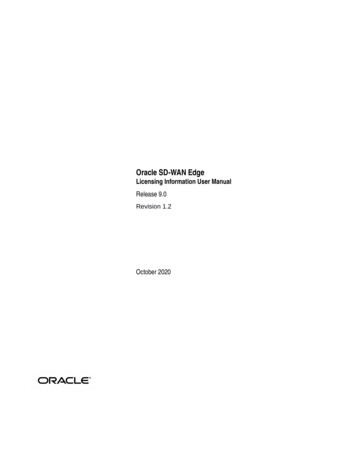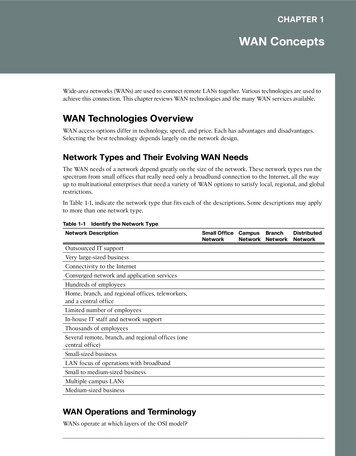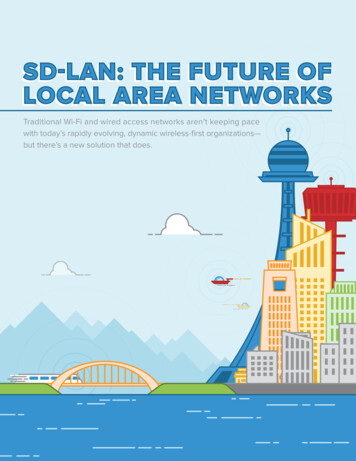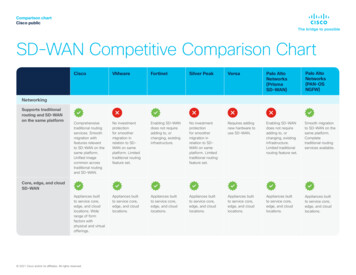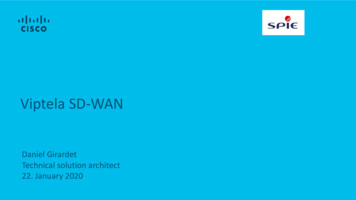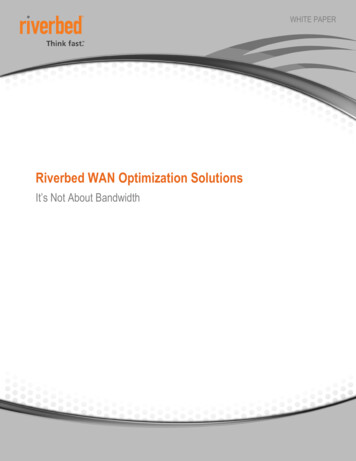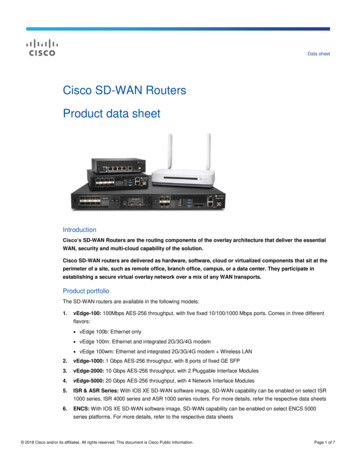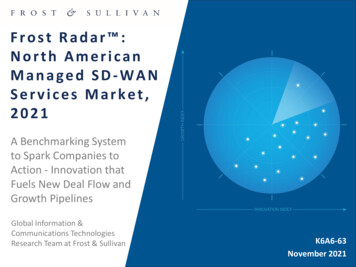
Transcription
Frost Radar :North AmericanManaged SD-WANServices Market,2021A Benchmarking Systemto Spark Companies toAction - Innovation thatFuels New Deal Flow andGrowth PipelinesGlobal Information &Communications TechnologiesResearch Team at Frost & SullivanK6A6-63November 2021
Strategic Imperativeand GrowthEnvironment2
The Strategic Imperative The North American managed software-defined wide area network (SD-WAN) services market is in thegrowth phase of the product life cycle. Across industries, businesses are embracing these services as anintegral part of their WAN transformation strategy, largely to gain cost and operational efficiencies. In 2020,market revenues exceeded 2 billion, with more than 180,000 sites operational today. However, as SD-WAN deployments have increased in the last 3 years, businesses realize that installing andmanaging multiple SD-WAN sites is complex. The process can be daunting when it involves multiple transportand access providers from across the globe. A managed service provider with the expertise and technologyneeded to integrate disparate operations and management systems from various access providers can helpaddress the complexity. Hence, fully managed SD-WAN services continue to gain traction. Multiprotocol label switching (MPLS) and Ethernet WAN services are deeply embedded in business WANnetworks, and SD-WAN is challenging the status quo of these technologies. While some customers havechosen to create hybrid SD-WAN networks by adding broadband links to MPLS or Ethernet WANs, othershave chosen to disconnect private networks and instead utilize a combination of broadband, dedicatedinternet access (DIA), and wireless links. Managed SD-WAN presents service providers with upsell opportunities for hosted voice over internetprotocol (VoIP) and unified communication-as-a-service (UCaaS) offerings while creating customer stickiness.Combining managed SD-WAN services with hosted voice and collaboration services represents a compellingvalue proposition. In the past, these services have relied on MPLS links for superior performance. With anSD-WAN solution, enterprise users can benefit from improved application performance using dualinternet-based links.Source: Frost & SullivanK6A6-633
The Strategic Imperative (continued) The growth of Internet of Things (IoT) applications and the need to process data faster for latency-sensitiveapplications are driving demand for edge computing. 5G mobile networking is critical to the success of edgecomputing because of its high-speed and low-latency bandwidth features. SD-WAN facilitates automated,optimized, and secure connectivity over 5G between endpoints (users or things) and edge compute nodes.The network slicing feature of 5G enables an SD-WAN platform to request virtualized slices on the networkfor different applications, based on centrally defined policies. SD-WAN vendors are looking to ship SD-WANappliances with integrated 5G support to tap into edge computing and 5G trends, which will open up moreopportunities for service providers to include wireless as part of their managed SD-WAN offering. Most managed SD-WAN providers have a multi-vendor partner strategy with an average of 3-partnersolutions. The Cisco Meraki solution, which is prevalent in the enterprise LAN and security space, is gainingtraction for SD-WAN functionality, especially down market, in the small and lower end of midmarketsegments. The solution’s simplicity, which allows fast deployment at low costs, is attracting customers.Whether this interest is temporary, due to the COVID-19 pandemic, or long term remains undetermined asthe solution is limited in features and bandwidth as business needs change. Cost-effective branch site connectivity, fast deployment times, centralized network management, andoptimized cloud connectivity are some the drivers for managed SD-WAN adoption. In particular, a cloud-firstbusiness strategy has made SD-WAN highly relevant in the market. As companies look to improve businessefficiency by embracing cloud, connectivity becomes a critical component of their digital transformationstrategy. Enterprise IT will distribute their applications across multiple clouds, and SD-WAN enables them topredefine business policies through the SD-WAN controller and to specify which cloud applications aresuitably accessed directly through the Internet versus backhauled to a hub site.Source: Frost & SullivanK6A6-634
The Strategic Imperative (continued) Secure access service edge (SASE) combines network and security functions in one framework, which issoftware-defined and delivered from the cloud through distributed SASE points of presence (PoPs). Users(and devices) connect to the nearest SASE PoP (deployed in on-premises or at third-party data centers,network POPs, security PoPs, or cloud PoPs), which determines the optimal routing and security policies forthe endpoint trying to access cloud (IaaS, SaaS, and PaaS) applications. The routing and security policies foreach application are applied based on the identity of the entity, real-time context, enterprisesecurity/compliance policies, and continuous assessment of risk/trust throughout the sessions. While the aimof SASE is to deliver a comprehensive set of virtual security services (that were typically deployed onpremises on a physical appliance at enterprise data centers) from the cloud, the critical components includedare next-generation firewall, SD-WAN, zero trust network access (ZTNA), and secure web gateway (SWG). SASE has become somewhat of an industry buzzword right now with vendors and service providers rushing tobrand their SD-WAN and security offerings as SASE. Discussions with enterprise IT decision makers indicatethat most of them do not even fully understand the definition of SASE, and most certainly, a small percentageof the businesses have deployed all of the SASE components. Interviews with vendors and service providersvalidate this market perception as they are getting requests for information about the SASE solutions they arecapable of delivering, now and in the future, but adoption is limited so far. Leading service providers haveadded security-centric SD-WAN vendors (such as Fortinet and Palo Alto Networks) to their portfolio toposition themselves competitively to tap into emerging SASE opportunities. Frost & Sullivan believes there is value in delivering both networking and security functions from the cloud.However, existing enterprise WAN architectures and needs are way too complex to depend solely on acloud-based model. A hybrid model consisting of on-prem and cloud-delivered secure SD-WAN (thatcombines SD-WAN and some security components) is more ideal to address businesses’ needs. A SASEsolution is more of a spectrum, which should have an on-prem anchor and some cloud elements, and itshould be able to slide between the two.Source: Frost & SullivanK6A6-635
The Strategic Imperative (continued) When the COVID-19 pandemic hit the global workforce in March 2020, remote work became the new norm.Businesses across industries use the public cloud to host key applications, and with advances in residentialbroadband and wireless speeds, remote workers can access most enterprise applications from home. Yesremote workers, remote students, and video streamers under one roof compete for bandwidth, so optimizingand prioritizing business applications on home networks is a challenge. SD-WAN solutions leverage real-timeperformance monitoring of transport networks to make application-aware, policy-based network linkselections and steer traffic over the best available link. The rise in remote working creates opportunities formanaged SD-WAN providers to bundle business-grade broadband/Internet and business wireless serviceswith SD-WAN to tap the market opportunity. The concept of self-healing WAN has been at the core of SD-WAN discussion since its inception, owing to itsSDN roots. Vendors and providers alike are investing in and integrating artificial intelligence (AI) and machinelearning (ML) tools to deliver on the promise of application-aware or intent-based networking to automateroutine network operation tasks, set policies, measure network performance against set targets, and respondto and rectify the networks as needed. Solutions available today are capable of predicting events andnotifying about them, with providers working on incorporating robotic process automation to eliminatemanual intervention and instead have the WAN self-correct. Today, Masergy and Windstream Enterprise aretwo service providers that have enabled AIOps capability with their managed SD-WAN offerings.Source: Frost & SullivanK6A6-636
The Strategic Imperative (continued) While the market is currently flooded with purpose-built SD-WAN appliances, the network functionvirtualization (NFV)-based universal customer premises equipment (uCPE) approach is clearly gainingprominence, with most managed SD-WAN providers featured in this report supporting it. The cost of uCPEand the complexity of service chaining were two challenges service providers faced in the past, whichresulted in businesses choosing the easier route of installing an SD-WAN appliance approach. That trend ischanging fast. The uCPE price has decreased by more than 50% in the last two years, and service providershave invested in network management tools and orchestration platforms to enable seamless servicechaining. The ability to deploy multiple key network functions in virtual formats—routing, security, WANoptimization, session border controllers—is of immense value to businesses in terms of network scalability,manageability, and reducing appliance sprawl. In the 2021 Frost & Sullivan Global WAN Virtualization Trendsend-user survey, IT decision makers listed virtual network services as the third-most important technologytrend of priority for the next 24 months. As the NFV-based approach gains traction, the ability to instantiate VNFs on the uCPE, in the cloud, at theedge, and on any virtualized platform becomes critical. Service providers are focused on developing domainorchestration capabilities to seamlessly deploy and manage network functions when needed. As SDN, NFV, and SD-WAN technologies converge, advanced self-service portals that provide a single pane ofglass view gain importance among network administrators. While most managed SD-WAN providers offerinsights into overlay and underlay performance metrics through their portals, some service providers areoffering self-service portals that provide a comprehensive view of key network solutions (VoIP, UCaaS,security) as well as SD-WAN and underlay networks.Source: Frost & SullivanK6A6-637
The Growth EnvironmentManaged SD-WAN Defined: In managed SD-WAN, the service provider acts as a single point of contact for thecomplete SD-WAN solution, including the SD-WAN appliance, software license, WAN services, and managedservices.Provider responsibilities in a managed SD-WAN service include: Procuring, installing, configuring, and managing the SD-WAN edge device (physical or virtual) and software Installing and managing the WAN links—their own, from a partner, or provided by the customer—thatsupport the SD-WAN solution Managing (at least partially) moves, adds, and changes across the SD-WAN solution Monitoring the service 24x7, troubleshooting, and restoring it in case of a problem Offering a service level agreement (SLA) for the entire solution and ensuring that performance guaranteesoffered in the SLA are met Creating optional value-added services such as WAN aggregation and continuity configurations, third-partyaccess management, additional security features, or WAN optimization, to list a few Supporting IT managers with a self-service portal interface that provides a granular level of visibility andcontrol Billing for the service in a subscription-based model, where the customer pays a monthly recurring charge(MRC) for the managed SD-WANo While some providers bill managed SD-WAN services as a single MRC for the edge device, bandwidth,and management, others charge bandwidth fees separatelySource: Frost & SullivanK6A6-638
The Growth Environment (continued)A managed SD-WAN service can either be fully managed, with the provider managing all aspects of the solution,or partially managed/co-managed, with the enterprise IT team retaining control over some aspects. Serviceprovider interviews indicate that while enterprises want to retain some control over the SD-WAN deployment,particularly related to policy management rights given to select employees, most want the service provider toassume troubleshooting responsibilities. In the fully-managed option, customers still have visibility into networkperformance characteristics.The managed SD-WAN market consists of the following 4 segments:Network service providers (NSPs): This segment includes companies such as AT&T and Verizon that can combinetheir own network services with networks the customer decides to bring. However, most often, the customerstands to benefit from the network services owned by the provider because doing so offers tighter integration ofSD-WAN solutions with the network and enables the provider to offer better SLAs.Managed service providers (MSPs): This segment includes companies such as Masergy and TPx that offermanaged services for a plethora of enterprise solutions, for example, network, security, unified communications,and cloud services. They generally have partnerships with several network and solution vendors and are in aposition to combine SD-WAN with managed network services and offer optional value-added services as theend customers’ needs grow. While a handful of large providers dominate this segment, several small regionalproviders offer managed SD-WAN services to compete.Source: Frost & SullivanK6A6-639
The Growth Environment (continued)System integrators (SIs): This segment includes companies such as Tech Mahindra and IBM that have long beenkey participants in the managed network services space; large enterprise customers prefer working with SIs thatcan bring IT and network solutions together and reduce the burden of dealing with multiple network andsolution vendors. SIs are quickly expanding their portfolios to include managed SD-WAN services, in response tocustomer demand.Value-added resellers (VARs): This segment includes companies such as Avant and Telarus. VARs have emergedas a key channel through which some enteprises prefer to buy managed SD-WAN. VARs are able to bring theoptimal set of solutions by partnering with various providers. Customers benefit from working through onechannel to procure solutions that are from different vendors but that appear as one cohesive solution. It alsohelps customers future-proof technology investments, as VARs are in a position to migrate their customers toevolving technologies. Some VARs partner directly with SD-WAN vendors, combining their SD-WAN solutionswith networks from different service providers to offer managed SD-WAN to end customers. VARs also act aschannel partners for NSPs and MSPs selling managed SD-WAN in the market.Source: Frost & SullivanK6A6-6310
Frost Radar North AmericanManaged SD-WANServices Market11
Frost Radar : North American Managed SD-WAN ServicesMarketSource: Frost & SullivanK6A6-6312
Frost Radar : Competitive Environment The North American managed SD-WAN service market remains fragmented with NSPs, MSPs, SIs, and VARscompeting for opportunities across business segments. While large NSPs and MSPs have significant SD-WANdeployments to their credit, the VARs and master agents channels dominate a large share of market revenuestoday. VARs resell a plethora of communication services (e.g., network services, VoIP, UCaaS, security,SD-WAN) from several providers, giving them the flexibility to tap into a larger market opportunity. NSPs andMSPs partner with SIs and VARs to resell or white label their SD-WAN offering along with other solutions theydeliver. In this Radar report, Frost & Sullivan focuses on leading NSPs and MSPs that have full-fledged managedSD-WAN offerings in the market. Service providers are primarily analyzed based on their managed SD-WANportfolios, which include but are not limited to: Choice of SD-WAN vendor solutions; the underlay choices;managed service support before, during, and after deployment; self-service portals and networkmanagement capabilities; and the ability to deliver on value-added services to create customer stickiness(security, routing, VoIP, UCaaS). The competitive Radar mapping is based on full year 2020 quantitative data(a combination of operational sites and revenues) and features and functionalities that have been generallyavailable in the market for at least six months. Hughes is one of the largest managed SD-WAN providers in the market, with thousands of operationalSD-WAN sites across North America and internationally. Hughes has successfully upgraded many existingmanaged network services customers to SD-WAN functionality, resulting in a large installed base. Hughes hasmore than 100 managed SD-WAN customers, with an average network size of more than 350 spanning retail,healthcare, banking, petroleum, restaurant, and government verticals.Source: Frost & SullivanK6A6-6313
Companies to ActionCompanies to be Considered Firstfor Investment, Partnerships, or Benchmarking14
Hughes Network ServicesINNOVATION As a leading provider of managed networkservices, Hughes attracts customers as a onestop shop for network design, integration,operations, security, billing, andmanagement. HughesON managed SD-WAN combinesbest-of-breed connectivity via wireline,wireless, and satellite technologies to helpenterprises achieve their business objectives. The Hughes managed SD-WAN portfolioincludes VMware SD-WAN, Fortinet, CiscoMeraki, and Hughes platforms to bestaddress customer needs. With its focus on automation, Hughes hasconsolidated its vendors and platforms onto acommon orchestration system, extendingautomation support into the LAN andexpanding co-management options andintegrations. Leveraging AI and AIOps, HughesONManaged Services come with a self-healingfeature that automatically remediates WANedge and LAN devices, including firewalls, SDWAN platforms, switches, and APs frommultiple vendors.GROWTHFROST PERSPECTIVE With thousands of operational SD-WAN sitesacross North America and internationally,Hughes is one of the largest managed SDWAN providers in the market. Hughes hassuccessfully upgraded many existing managednetwork services customers to SD-WANfunctionality, resulting in a large installedbase. Hughes is one of the largest broadbandaggregators in the market, with more than450 broadband provider partnersconnecting more than 212,000 end-points inNorth America. This robust access portfolioincludes T1, MPLS, DSL, cable, fiber,Ethernet, satellite, wireless, and microwavetechnologies, enabling it to connectdistributed sites with varying performanceneeds. As SD-WAN makes site typingincreasingly critical, Hughes has theadvantage of delivering a variety oftransport and vendor choices, all optimizedon a site-by-site basis. Hughes has more than 100 managed SD-WANcustomers, with an average network size ofmore than 350 spanning the retail,healthcare, banking, petroleum, restaurant,and government verticals, to list a few. The company functions exclusively via directsales to enterprises and is successful in sellingto verticals that operate in a franchise model;for example, within Exxon Mobil, eachcustomer franchise can represent hundreds oflocations. The VMware partnership fortifies Hughes’competitive position, enabling it to serve amuch broader market by using VMware’sunique gateway-centric approach thatappeals to businesses looking for optimizedand secure cloud connectivity. Fortinet further strengthens Hughes’competitive positioning, attractingcompanies looking for security and singleplatform solutions.Source: Frost & SullivanK6A6-6315
StrategicInsights16
Strategic Insights1The economic downturn caused by the COVID-19 pandemic affected technology spending in 2020 as highlydistributed verticals such as retail and manufacturing were negatively impacted. However, vendors reportthat the market started to recover in Q4 2020. With the vaccination rollout, the North American andEuropean markets are beginning to slowly recover. As businesses reassess their technology spend, SD-WANwill emerge as a top choice for their networking needs, which will contribute to higher growth rates beyond2022.12SASE has become somewhat of an industry buzzword right now with vendors and service providers rushing tobrand their SD-WAN and security offerings as SASE. Interviews with vendors and service providers validatethis market perception as they are getting requests for information about the SASE solutions they are capableof delivering, now and in the future, but adoption is limited so far.13MPLS and Ethernet WAN services are deeply embedded in business WAN networks, and SD-WAN ischallenging the status quo of these technologies. While some customers have chosen to create a hybrid SDWAN network by adding broadband links to MPLS or Ethernet WANs, others have chosen to disconnectprivate networks and instead utilize a combination of broadband, DIA, and wireless links. Managed SD-WANprovider interviews indicate that a majority of the SD-WAN sites in operation today use DIA, broadband, andwireless links.Source: Frost & SullivanK6A6-6317
Next Steps:Leveraging theFrost Radar toEmpower KeyStakeholders18
Significance of Being on the Frost Radar GROWTH POTENTIALYour organization has significant future growth potential, whichmakes it a Company to Action.BEST PRACTICESCompanies plotted on theFrost Radar are the leadersin the industry for growth,innovation, or both. They areinstrumental in advancing theindustry into the future.Your organization is well positioned to shape Growth Pipeline bestpractices in your industry.COMPETITIVE INTENSITYYour organization is one of the key drivers of competitive intensity inthe growth environment.CUSTOMER VALUEYour organization has demonstrated the ability to significantlyenhance its customer value proposition.PARTNER POTENTIALYour organization is top of mind for customers, investors, value chainpartners, and future talent as a significant value provider.Source: Frost & SullivanK6A6-6319
Frost Radar Empowers the CEO’s Growth TeamSTRATEGIC IMPERATIVE Growth is increasinglydifficult to achieve. Competitive intensity ishigh. More collaboration,teamwork, and focus areneeded. The growth environment iscomplex.LEVERAGING THE FROST RADAR The Growth Team has the tools needed tofoster a collaborative environment amongthe entire management team to drive bestpractices. The Growth Team has a measurementplatform to assess future growth potential.NEXT STEPS Growth Pipeline Audit Growth Pipeline as aService Growth Pipeline Dialogue with TeamFrost The Growth Team has the ability to supportthe CEO with a powerful Growth PipelineTM.Source: Frost & SullivanK6A6-6320
Frost Radar Empowers InvestorsSTRATEGIC IMPERATIVE Deal flow is low andcompetition is high. Due diligence is hamperedby industry complexity. Portfolio management isnot effective.LEVERAGING THE FROST RADAR Investors can focus on future growthpotential by creating a powerful pipeline ofCompanies to Action for high-potentialinvestments. Investors can perform due diligence thatimproves accuracy and accelerates the dealprocess.NEXT STEPS Growth Pipeline Dialogue Opportunity UniverseWorkshop Growth Pipeline Audit as Mandated DueDiligence Investors can realize the maximum internalrate of return and ensure long-term successfor shareholders. Investors can continually benchmarkperformance with best practices for optimalportfolio management.Source: Frost & SullivanK6A6-6321
Frost Radar Empowers CustomersSTRATEGIC IMPERATIVE Solutions are increasinglycomplex and havelong-term implications. Vendor solutions can beconfusing. Vendor volatility adds tothe uncertainty.LEVERAGING THE FROST RADAR Customers have an analytical framework tobenchmark potential vendors and identifypartners that will provide powerful,long-term solutions. Customers can evaluate the mostinnovative solutions and understand howdifferent solutions would meet their needs.NEXT STEPS Growth Pipeline Dialogue Growth Pipeline Diagnostic Frost Radar Benchmarking System Customers gain a long-term perspective onvendor partnerships.Source: Frost & SullivanK6A6-6322
Frost Radar Empowers the Board of DirectorsSTRATEGIC IMPERATIVELEVERAGING THE FROST RADAR Growth is increasinglydifficult; CEOs requireguidance. The Board of Directors has a uniquemeasurement system to ensure oversight ofthe company’s long-term success. The Growth Environmentrequires complexnavigational skills. The Board of Directors has a discussionplatform that centers on the driving issues,benchmarks, and best practices that willprotect shareholder investment. The customer value chain ischanging.NEXT STEPS Growth Pipeline Audit Growth Pipeline as aService The Board of Directors can ensure skillfulmentoring, support, and governance of theCEO to maximize future growth potential.Source: Frost & SullivanK6A6-6323
Frost Radar Analytics24
Frost Radar : Benchmarking Future Growth Potential2 Major Indices, 10 Analytical Ingredients, 1 PlatformGROWTH INDEX ELEMENTSVERTICAL AXISGrowth Index (GI) is a measure ofa company’s growth performanceand track record, along with itsability to develop and execute afully aligned growth strategy andvision; a robust growth pipeline system; and effective market,competitor, and end-user focusedsales and marketing strategies. GI1: MARKET SHARE (PREVIOUS 3 YEARS)This is a comparison of a company’s market share relative to itscompetitors in a given market space for the previous 3 years. GI2: REVENUE GROWTH (PREVIOUS 3 YEARS)This is a look at a company’s revenue growth rate for the previous 3 yearsin the market/industry/category that forms the context for the givenFrost RadarTM. GI3: GROWTH PIPELINE This is an evaluation of the strength and leverage of a company’sgrowth pipeline system to continuously capture, analyze, and prioritizeits universe of growth opportunities. GI4: VISION AND STRATEGYThis is an assessment of how well a company’s growth strategy is alignedwith its vision. Are the investments that a company is making in newproducts and markets consistent with the stated vision? GI5: SALES AND MARKETINGThis is a measure of the effectiveness of a company’s sales and marketingefforts in helping it drive demand and achieve its growth objectives.K6A6-6325
Frost Radar : Benchmarking Future Growth Potential2 Major Indices, 10 Analytical Ingredients, 1 PlatformINNOVATION INDEX ELEMENTSHORIZONTAL AXISInnovation Index (II) is a measureof a company’s ability to developproducts/services/solutions (witha clear understanding ofdisruptive Mega Trends) that areglobally applicable, are able toevolve and expand to servemultiple markets, and are alignedto customers’ changing needs. II1: INNOVATION SCALABILITYThis determines whether an organization’s innovations are globallyscalable and applicable in both developing and mature markets, and alsoin adjacent and non-adjacent industry verticals. II2: RESEARCH AND DEVELOPMENTThis is a measure of the efficacy of a company’s R&D strategy, asdetermined by the size of its R&D investment and how it feeds theinnovation pipeline. II3: PRODUCT PORTFOLIOThis is a measure of a company’s product portfolio, focusing on therelative contribution of new products to its annual revenue. II4: MEGA TRENDS LEVERAGEThis is an assessment of a company’s proactive leverage of evolving,long-term opportunities and new business models, as the foundation ofits innovation pipeline. An explanation of Mega Trends can be found here. II5: CUSTOMER ALIGNMENTThis evaluates the applicability of a company’sproducts/services/solutions to current and potential customers, as well ashow its innovation strategy is influenced by evolving customer needs.K6A6-6326
Legal DisclaimerFrost & Sullivan is not responsible for any incorrect information supplied by companies or users.Quantitative market information is based primarily on interviews and therefore is subject to fluctuation.Frost & Sullivan research services are limited publications containing valuable market informationprovided to a select group of customers. Customers acknowledge, when ordering or downloading, thatFrost & Sullivan research services are for internal use and not for general publication or disclosure tothird parties. No part of this research service may be given, lent, resold, or disclosed to noncustomerswithout written permission. Furthermore, no part may be reproduced, stored in a retrieval system, ortransmitted in any form or by any means—electronic, mechanical, photocopying, recording, orotherwise—without the permission of the publisher.For information regarding permission, write to:Frost & Sullivan3211 Scott Blvd., Suite 203Santa Clara, CA 95054 2021 Frost & Sullivan. All rights reserved. This document contains highly confidential information and is the sole property of Frost & Sullivan.No part of it may be circulated, quoted, copied, or otherwise reproduced without the written approval of Frost & Sullivan.K6A6-6327
The North American managed software-defined wide area network (SD-WAN) services market is in the growth phase of the product life cycle. . predefine business policies through the SD-WAN controller and to specify which cloud applications are . security, WAN optimization, session border controllers—is of immense value to businesses in .

